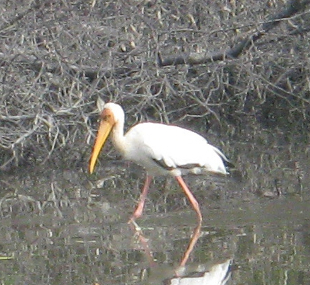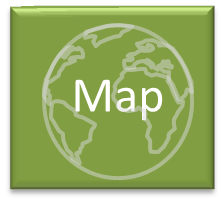
Sungei Buloh wetland reserves |
| Location | Neo Tiew Crescent, Singapore |
|---|---|
| Terrain | Dirt road |
| Recommended duration | 2 to 3 hours |
| Ease of access | Can be reached using public transport |
| Special equipment | None |
| Good | Well maintained |
| Not so good | Mosquitoes |
Sungei Buloh is a designated wetland reserves in Singapore in recognition of its importance as a site for migratory birds. The wetland reserve is home to many resident birds such as herons, egrets, hornbills and sunbirds. Its mangrove mudflats are also a winter rest stop for migratory waders from September to March. Although more well known for its bird life, there are also many other native reptiles and mammals that reside within its compound. Monitor lizards, some more than meter long, often share the beaten path used by visitors. Crocodile can sometimes be spotted resting on the muddy banks or swimming near the tidal gates.
A large part of Sungei Buloh used to be prawn farms thus the land had been modified with raised embankments to form pools that are connected to each other and the sea with sluice gates. The embankments now form the beaten path which visitors walked on. Many mangrove trees were replanted along the side of the embankments when it is designated as a wetland reserve. Compared to the mangrove forests in some other parts of Singapore, many of the mangrove trees here are relatively young. While much of the land is predominantly mangrove forest habitat, the reserve also contains some fresh water ponds and shrub lands.
Most birds tend to stay at a distance from human, therefore, a good pair of binoculars will be useful if you wish to have a close-up view of them. To see the abundance of wildlife, look through the vegetation and trees that lines the path and you may be rewarded with glimpse of otters and even the occasional crocodiles. Water monitor lizards are often encountered sun bathing on the path but they are generally safe. As for crocodiles, visitors are advised to keep their distance. Insect repellent should be applied to any expose skin as there are mosquitoes throughout the wetland.
The park is designed to blend man-made structure with nature to minimize disturbance and interference to wildlife while allowing human obervers. Visitors to the reserve will first pass through a well-maintained visitor center and show room. Toilets and souvenir shop are also found near the entrance. Once in the reserve, there are extensive raised walkways that cuts through the mangrove forests. Sheltered and simple see-through hides are scattered along the path which provide unobstructed views of the habitat without disturbing the wildlife. Towers that rise above the trees provide a top view of the land and is ideal for spotting raptors in the sky.
The best time to visit the park is during the early morning and evening when it is cooler and the birds are more active. Check the tide table. At low tide, more mud flats are exposed for the birds to feed although the park will also control the flooding of the mud flats so that there will be places for the waders and other wetland birds to rest at high tides. Although there are many resident birds and animals that reside in the part whole year round, more birds especially wetland birds can be seen during the migratory season which is from September to March. During this season, birds from as far as Sibera comes down to the warmer equator and southern hemisphere to avoid the winter back at home.
Flora and Fauna
Squirrel |

Stork |
|

Crocodile |

Hornbills |
|

Water monitor lizard |
||
Different spieces of mangrove trees with their unique root system |
||

|

|
|

|
||

| Sungei Buloh was formerly a forest reserve back in 1890 and consists entirely of mangrove swamp2. However in 4th April 1938, an area of approximately 457 hectares was no longer designated as a forest reserve according to the Straits Settlement Government Gazette, 19382. Much of the mangrove forests were cleared for prawn and fish farming. These were abandoned in 1989 and the Government took over the site. The wetland area covering 87 hectares was designated as a nature park on the same year following a proposal put up by then Malayan Nature Society (Singapore Branch) 3, 4. Development of the park starts in 1990 and it takes three years at a cost of $8.5 million5 to complete its transformation which includes replanting the mangrove trees that lines the river bank. The park is officially opened to public on 06 December 19934. On 10 November 2001, Sungei Buloh is gazette as Nature Reserves and on 1 January 2002, the park was renamed Sungei Buloh Wetland Reserve covering an area of 130 hectares 4. |

7.30am to 7.00pm on Monday to Saturday
7.00am to 7.00pm on Sundays & Public Holidays


Mondays to Saturdays
Board SMRT Bus 925 from Kranji MRT station. Alight at Kranji Reservoir Carpark (Note. Bus makes a U-turn here). 15 minutes walk to Reserve. Cost: SGD 0.98 using ez-link card; SGD 1.50 using cash
Number of bus stops: 12
Sundays and Public Holidays
SMRT Bus 925 stops at Reserve's entrance
Duration: 20 min
Check SMRT bus guide for more details



- Drab or skin-tone clothings
- Binoculars
- Umbrella (in case of rain)
- Cap/Hat
- Insect repellent
- Water

- Sungei Buloh Wetland Reserve Official Website.
- Peter K L Ng, N Sivasothi. Guide to the Mangroves of Singapore. Sungei Buloh Nature Park. http://mangrove.nus.edu.sg/guidebooks/text/1019.htm.
- Wild Singapore. Sungei Buloh Wetland Reserve. http://www.wildsingapore.com/places/sbwr.htm. [03 Dec 2014].
- Our History. Sungei Buloh Wetland Reserve. https://www.sbwr.org.sg/aboutus/ourhistory/. [03 Dec 2014].
- Sungei Buloh Nature Park. Singapore infopedia. http://eresources.nlb.gov.sg/infopedia/articles/SIP_566_2005-02-01.html. [03 Dec 2014]
